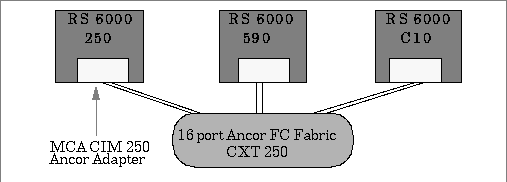
Communication benchmarks with the Ancor Fibre Channel Fabric
The aim of this work is to measure communication times for transferring data from memory to memory between RS/6000 IBM workstations via a 16 port Ancor Fibre Channel Fabric (or Switch). In fact, not only the performance of the switch is measured, but also the performance of the interfaces and the software (drivers).
Figure 1 shows the experimental hardware configuration used. One machine is a 250 model with a PowerPC 601 processor at 66 MHz, the second one is a 590 model with a Power2 processor at 66 MHz, and the third one is a C10 model with a PowerPC 601 at 80 MHz. A MCA CIM (Micro Channel Architecture Communications Interface Module) 250 Ancor adapter is located in each workstation to provide access to the Fibre Channel world

Figure 1: Experimental hardware configuration.
The MCA CIM 250 interface to the MCA bus (RS/6000 IBM workstation) is a 32 bit bus Master capable of data transfer rates up to 40 MBytes/s and it should not represent a bottleneck in this system, where the speed of each 50 micron optic fibre is 266 Mbits/s. For more details about the Fibre Channel Standard, the Fibre Channel fabric and adapters, see [1], [2], [3] and [4].
The driver available for MCA CIM 250 adapters can support two different interfaces:
We performed transmission tests using both interfaces albeit for our application we are interested in using the most optimized one (providing the best bandwidth), viz the Direct Channel interface. Results are reported hereinafter.
Generated with WebMaker